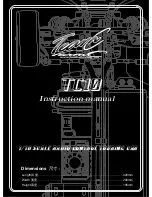
18
TOE - THEORY
TOE - MEaSURING
FRONT TOE
Increased
(more toe-in)
• Increases understeer (decreases oversteer).
• Decreases steering at corner entry.
• Increases “nervousness.”
• Makes car more difficult to drive.
Decreased
(more toe-out)
• Decreases understeer (increases oversteer).
• Increases steering at corner entry.
• Increases straight-line stability.
• Makes car easier to drive.
REAR TOE
Increased
(more toe-in)
• Increases understeer.
• Increases on-power stability at corner exit and braking at corner entry.
• Less chance of losing rear traction.
• Increases straight-line stability.
Decreased
(less toe-in)
• Decreases on-power stability at corner exit and braking.
• More chance of losing rear traction.
InITIAl STepS
SeT-Up cOmpOnenTS:
Prepare the car as follows:
Use the following set-up components:
·
Shocks: Attach the front and rear shocks.
·
Wheels: Remove the wheels.
·
assembled set-up stands
·
toe gauge
1. Assemble the set-up stands.
. Mount the set-up stands on the axles.
. Place the car on the set-up board.
. To adjust rear toe, set the toe gauge atop the rear set-up stands.
The pins at the top of the stands fit in the machined slots in the toe gauge.
. To read the toe value of the left rear wheel, push the toe gauge to the right until the pin on the
top edge of the left set-up stand hits the edge of the slot in the toe gauge.
Now read the toe value on the toe gauge. The black line on the top edge of the stand points to a
toe value engraved in the toe gauge. Each graduated mark indicates a 1° toe value. You should
be able to set toe with a resolution of 0.°
TOE
Toe is the angle of the wheels when looked at from above the car. Toe
is used to stabilize the car at the expense of traction, as it introduces
friction and therefore some slip in the tires.
When the wheels are parallel with the centerline of the car, toe is 0°
(neutral). When the wheels are closed towards the front, this is called
toe-in (positive value). When the wheels are open towards the front,
this is called toe-out (negative value).
The front wheels can have either toe-in or toe-out. The rear wheels
should always have toe-in; they should never have toe-out.
We recommend that you first adjust the rear toe, if your car allows it,
then put the car on the track and adjust the steering trim so that the
car tracks straight. Then you can proceed to the front toe adjustment
back in the pits. Rear toe-in is a primary adjustment, and will dictate
the symmetry of the handling of the car. It is critical that you adjust
rear toe-in perfectly symmetrical from left to right.
to
e
in
to
e
ou
t
0
to
e
in
to
e
ou
t
0
















































